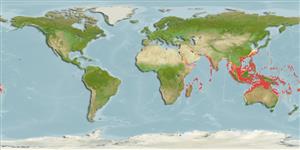>
Mulliformes (Goatfishes) >
Mullidae (Goatfishes)
Etymology: Parupeneus: Latin, parum, parvum = small + Peneus, the name of a river.
More on author: Lacepède.
Environment: milieu / climate zone / depth range / distribution range
นิเวศวิทยา
เกี่ยวกับทะเล,น้ำเค็ม เกี่ยวกับหินโสโครก; ไม่มีการอพยพย้ายถิ่น; ระดับความลึก 0 - 125 m (Ref. 90102). Tropical; 30°N - 35°S, 35°E - 124°W (Ref. 54393)
Indo-Pacific: Red Sea and east coast of Africa south to Durban, South Africa, east to the Hawaiian Islands, islands of French Polynesia and the Pitcairn Islands, north to the Ryukyu Islands and Ogasawara Islands, Japan south to Australia.
ขนาด / น้ำหนัก / Age
Maturity: Lm ? range ? - ? cm
Max length : 50.0 cm TL เพศผู้/กระเทย; (Ref. 30573); common length : 35.0 cm TL เพศผู้/กระเทย; (Ref. 30573); น้ำหนักสูงสุดที่มีการรายงาน: 2.3 kg (Ref. 4887)
เงี่ยงครีบหลัง (รวม): 8; ก้านครีบอ่อนที่หาง (รวม): 9; เงี่ยงครีบก้น 1; ก้านครีบอ่อนที่ก้น: 7. This species is distinguished by the following characters: pectoral rays 16 (rarely 15 or 17); gill rakers 6-7 + 22-26 = 29-33; body depth 3.25-3.8 in SL (body deeper with growth); head length (HL) 2.85-3.1 in SL; snout long, its length 1.61.8 in HL; eye small, the orbit diameter 5.3-8.95 in HL (SL 118-392 mm); barbels very long, 1.15 in HL to longer than head; longest dorsal spine 1.5-1.7 in HL; penultimate dorsal ray 1.1-1.2 in length of last dorsal ray; pectoral-fin length 1.5-1.7 in HL; pelvic-fin length 1.35-1.55 in HL. Colour of large adults yellowish gray, edges of the scales bright blue except ventrally, edges more broadly blue posteriorly; a large, hemispherical, saddle-like, yellow spot covering most of upper half of caudal peduncle; region around eye yellow with radiating short narrow blue bands; caudal fin with longitudinal blue bands; second dorsal and anal fins with narrow oblique blue bands; a second smaller color phase entirely yellow, with dorsal peduncular spot sometimes apparent by being brighter yellow than rest of body (Ref. 54393).
Found on coral (Ref. 58652), rocky, or rubble bottoms of reef flats, lagoons, and seaward reefs (Ref. 3921). Benthopelagic (Ref. 58302). Juveniles form schools, adults usually solitary. Feed primarily on small fishes, crustaceans, peanut worms, shrimps, crabs, octopi, and small gastropods during the day (Ref. 3921). Minimum depth reported taken from Ref. 128797.
Life cycle and mating behavior
วัยเจริญพันธุ์ | การสืบพันธุ์ | การวางไข่ | เซลสืบพันธ์ของเพศเมีย(ไข่) | ความดกของไข่ | ตัวอ่อน
Randall, J.E., 2004. Revision of the goatfish genus Parupeneus (Perciformes: Mullidae), with descriptions of two new species. Indo-Pac. Fish. (36):64 p. (Ref. 54393)
IUCN Red List Status (Ref. 130435)
Threat to humans
Reports of ciguatera poisoning (Ref. 4690)
Human uses
การประมง: การค้า; การตกปลาเป็นกีฬา: ใช่; สถานที่แสดงสัตว์และพืชน้ำ: การค้า
ข้อมูลเพิ่มเติม
ชื่อสามัญชื่อพ้องกลไกการเผาผลาญพลังงานผู้ล่าการศึกษาเกี่ยวกับผลกระทบของสารประกอบทางเคมีที่เป็นอันตรายต่อสิ่งมีชีวิต ประชากร และสิ่งแวดล้อมการสืบพันธุ์วัยเจริญพันธุ์การวางไข่การรวมกลุ่มวางไข่ความดกของไข่เซลสืบพันธ์ของเพศเมีย(ไข่)Egg development
อ้างอิงการเพาะเลี้ยงสัตว์น้ำประวัติการเพาะเลี้ยงสัตว์น้ำสายพันธุ์พันธุศาสตร์ElectrophoresesอัตราพันธุกรรมโรคการแปรรูปNutrientsMass conversion
เครื่องมือ
Special reports
Download XML
แหล่งที่มาจากอินเตอร์เน็ต
Estimates based on models
Preferred temperature (Ref.
123201): 24.5 - 29, mean 27.8 °C (based on 1578 cells).
Phylogenetic diversity index (Ref.
82804): PD
50 = 0.5000 [Uniqueness, from 0.5 = low to 2.0 = high].
Bayesian length-weight: a=0.01230 (0.00783 - 0.01932), b=3.09 (2.96 - 3.22), in cm total length, based on LWR estimates for this species & Genus-body shape (Ref.
93245).
ระดับชั้นอาหาร (Ref.
69278): 4.2 ±0.6 se; based on diet studies.
ความสามารถในการกลับคืนสู่ปกติ (Ref.
120179): ขนาดกลาง, เวลาต่ำสุดที่จะทำให้ประชากรเพิ่มขึ้นเป็น 2 เท่าใช้เวลา 1.4 - 4.4 ปี (Preliminary K or Fecundity.).
Fishing Vulnerability (Ref.
59153): Moderate vulnerability (40 of 100).
Nutrients (Ref.
124155): Calcium = 23.4 [12.2, 58.4] mg/100g; Iron = 0.3 [0.1, 0.7] mg/100g; Protein = 18 [15, 21] %; Omega3 = 0.132 [0.073, 0.254] g/100g; Selenium = 61.8 [28.3, 147.8] μg/100g; VitaminA = 292 [55, 1,307] μg/100g; Zinc = 0.39 [0.23, 0.74] mg/100g (wet weight);
